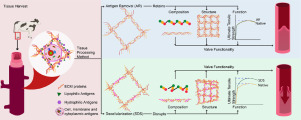当前位置:
X-MOL 学术
›
Acta Biomater.
›
论文详情
Our official English website, www.x-mol.net, welcomes your
feedback! (Note: you will need to create a separate account there.)
Antigen removal process preserves function of small diameter venous valved conduits, whereas SDS-decellularization results in significant valvular insufficiency.
Acta Biomaterialia ( IF 9.4 ) Pub Date : 2020-03-07 , DOI: 10.1016/j.actbio.2020.03.003 Manuela Lopera Higuita 1 , Leigh G Griffiths 2
Acta Biomaterialia ( IF 9.4 ) Pub Date : 2020-03-07 , DOI: 10.1016/j.actbio.2020.03.003 Manuela Lopera Higuita 1 , Leigh G Griffiths 2
Affiliation

|
Chronic venous disease (CVD) is the most common reported chronic condition in the United States, affecting more than 25 million Americans. Regardless of its high occurrence, current therapeutic options are far from ideal due to their palliative nature. For best treatment outcomes, challenging cases of chronic venous insufficiency (CVI) are treated by repair or replacement of venous valves. Regrettably, the success of venous valve transplant is dependent on the availability of autologous venous valves and hindered by the possibility of donor site complications and increased patient morbidity. Therefore, the use of alternative tissue sources to provide off-the-shelf venous valve replacements has potential to be extremely beneficial to the field of CVI. This manuscript demonstrates the capability of producing off-the-shelf fully functional venous valved extracellular matrix (ECM) scaffold conduits from bovine saphenous vein (SV), using an antigen removal (AR) method. AR ECM scaffolds maintained native SV structure-function relationships and associated venous valves function. Conversely, SDS decellularization caused significant changes to the collagen and elastin macromolecular structures, resulting in collagen fibril merging, elimination of fibril crimp, amalgaming collagen fibers and fragmentation of the inner elastic lamina. ECM changes induced by SDS decellularization resulted in significant venous valve dysfunction. Venous valved conduits generated using the AR approach have potential to serve as off-the-shelf venous valve replacements for CVI. STATEMENT OF SIGNIFICANCE: Retention of the structure and composition of extracellular matrix (ECM) proteins within xenogeneic scaffolds for tissue engineering is of crucial importance, due to the undeniable effect ECM proteins can impose on repopulating cells and function of the resultant biomaterial. This manuscript demonstrates that alteration or elimination of ECM proteins via commonly utilized decellularization approach results in complete disruption of venous valve function. Conversely, retention of the delicate ECM structure and composition of native venous tissue, using an antigen removal tissue processing method, results in preservation of native venous valve function.
中文翻译:

抗原去除过程保留了小直径静脉瓣膜导管的功能,而SDS脱细胞作用导致明显的瓣膜功能不全。
慢性静脉疾病(CVD)是美国最常见的慢性病,影响了超过2500万美国人。不管其高发生率,由于其姑息性质,当前的治疗选择都不理想。为了获得最佳治疗效果,可通过修复或更换静脉瓣膜来治疗具有挑战性的慢性静脉功能不全(CVI)病例。遗憾的是,静脉瓣膜移植的成功取决于自体静脉瓣膜的可用性,并因供体部位并发症和患者发病率增加而受到阻碍。因此,使用替代组织来源提供现成的静脉瓣膜置换术对CVI领域极为有利。该手稿展示了使用抗原去除(AR)方法从牛大隐静脉(SV)生产现成的功能齐全的带瓣膜的带阀细胞外基质(ECM)支架导管的能力。AR ECM支架保持了天然SV结构与功能的关系以及相关的静脉瓣膜功能。相反,SDS脱细胞作用导致胶原蛋白和弹性蛋白大分子结构发生显着变化,导致胶原蛋白原纤维合并,原纤维卷曲消除,胶原蛋白纤维合并以及内部弹性层裂。SDS脱细胞诱导的ECM变化导致严重的静脉瓣膜功能障碍。使用AR方法产生的带阀静脉导管有潜力用作CVI的现成静脉瓣膜替代品。重要性声明:对于组织工程而言,在异种支架中保留细胞外基质(ECM)蛋白的结构和组成至关重要,因为ECM蛋白对细胞的繁殖和所得生物材料的功能具有不可否认的作用。该手稿表明,通过常用的脱细胞方法改变或消除ECM蛋白会导致静脉瓣膜功能的完全破坏。相反,使用抗原去除组织加工方法保留脆弱的ECM结构和天然静脉组织组成,可以保留天然静脉瓣膜功能。由于不可否认的作用,ECM蛋白可以强加于细胞的繁殖和所得生物材料的功能上。该手稿表明,通过常用的脱细胞方法改变或消除ECM蛋白会导致静脉瓣膜功能的完全破坏。相反地,使用抗原去除组织加工方法保留脆弱的ECM结构和天然静脉组织的组成导致天然静脉瓣膜功能的保留。由于不可否认的作用,ECM蛋白可以强加于细胞的繁殖和所得生物材料的功能上。该手稿表明,通过常用的脱细胞方法改变或消除ECM蛋白会导致静脉瓣膜功能的完全破坏。相反,使用抗原去除组织加工方法保留脆弱的ECM结构和天然静脉组织组成,可以保留天然静脉瓣膜功能。
更新日期:2020-03-09
中文翻译:

抗原去除过程保留了小直径静脉瓣膜导管的功能,而SDS脱细胞作用导致明显的瓣膜功能不全。
慢性静脉疾病(CVD)是美国最常见的慢性病,影响了超过2500万美国人。不管其高发生率,由于其姑息性质,当前的治疗选择都不理想。为了获得最佳治疗效果,可通过修复或更换静脉瓣膜来治疗具有挑战性的慢性静脉功能不全(CVI)病例。遗憾的是,静脉瓣膜移植的成功取决于自体静脉瓣膜的可用性,并因供体部位并发症和患者发病率增加而受到阻碍。因此,使用替代组织来源提供现成的静脉瓣膜置换术对CVI领域极为有利。该手稿展示了使用抗原去除(AR)方法从牛大隐静脉(SV)生产现成的功能齐全的带瓣膜的带阀细胞外基质(ECM)支架导管的能力。AR ECM支架保持了天然SV结构与功能的关系以及相关的静脉瓣膜功能。相反,SDS脱细胞作用导致胶原蛋白和弹性蛋白大分子结构发生显着变化,导致胶原蛋白原纤维合并,原纤维卷曲消除,胶原蛋白纤维合并以及内部弹性层裂。SDS脱细胞诱导的ECM变化导致严重的静脉瓣膜功能障碍。使用AR方法产生的带阀静脉导管有潜力用作CVI的现成静脉瓣膜替代品。重要性声明:对于组织工程而言,在异种支架中保留细胞外基质(ECM)蛋白的结构和组成至关重要,因为ECM蛋白对细胞的繁殖和所得生物材料的功能具有不可否认的作用。该手稿表明,通过常用的脱细胞方法改变或消除ECM蛋白会导致静脉瓣膜功能的完全破坏。相反,使用抗原去除组织加工方法保留脆弱的ECM结构和天然静脉组织组成,可以保留天然静脉瓣膜功能。由于不可否认的作用,ECM蛋白可以强加于细胞的繁殖和所得生物材料的功能上。该手稿表明,通过常用的脱细胞方法改变或消除ECM蛋白会导致静脉瓣膜功能的完全破坏。相反地,使用抗原去除组织加工方法保留脆弱的ECM结构和天然静脉组织的组成导致天然静脉瓣膜功能的保留。由于不可否认的作用,ECM蛋白可以强加于细胞的繁殖和所得生物材料的功能上。该手稿表明,通过常用的脱细胞方法改变或消除ECM蛋白会导致静脉瓣膜功能的完全破坏。相反,使用抗原去除组织加工方法保留脆弱的ECM结构和天然静脉组织组成,可以保留天然静脉瓣膜功能。











































 京公网安备 11010802027423号
京公网安备 11010802027423号